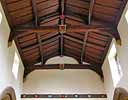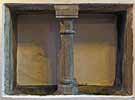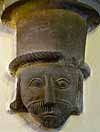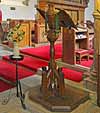Collingham All SaintsFeatures and Fittings
Font
 Font Font |
 Font cover Font cover |
The stone part of the font is thought to be Early English and in 1867 had a wooden cover dating from James I (Wake). The font itself has a round base with four octagonal columns which carry a plain octagonal bowl.
A long list of dilapidations of this church presented to the Archdeaconry Court of Nottingham in 1684 reported that ‘the cover of the font is wanting.’ The replacement, panelled 17th century font cover (dated 1684), with an intarsia decoration and chip carving remained in place in 1967.
Pulpit
 Pulpit Pulpit |
The pulpit was installed along with a new reading desk during the repairs of 1832.
Rood Screen
Wake (1867) records that the remnants of the old Rood Screen date from the 14th century and survive at an unnamed location away from the church and bear traces of gilt with blue and scarlet pigment and bear the Rose and occasionally the Shamrock and Thistle.
Heraldic Shields
 Above the chancel arch, at a height of 24 feet, are seven wooden heraldic shields which once decorated the underpart of 'so many misères or half seats used by the priests in the chancel.' Mee (1937) considered that these were over 400 years old and were placed in their present position when the stalls were destroyed in the 19th century. The description of the shields below is based on Wake (1867): Above the chancel arch, at a height of 24 feet, are seven wooden heraldic shields which once decorated the underpart of 'so many misères or half seats used by the priests in the chancel.' Mee (1937) considered that these were over 400 years old and were placed in their present position when the stalls were destroyed in the 19th century. The description of the shields below is based on Wake (1867):
 Shield 1 has three water-bougets (Roos) impaling a fesse between two bar gamelles (Badlesmere) Shield 1 has three water-bougets (Roos) impaling a fesse between two bar gamelles (Badlesmere)
 Shield 2 shows a chevron between 3 annulets and many crescents (Erisby) Shield 2 shows a chevron between 3 annulets and many crescents (Erisby)
 Shield 3 depicts a creature that is half dog and half horse. Shield 3 depicts a creature that is half dog and half horse.
 Shield 4 bears a Latin Cross with a sword and spear to its left and a falling dragon to its right (symbolising the overthrow of Satan) Shield 4 bears a Latin Cross with a sword and spear to its left and a falling dragon to its right (symbolising the overthrow of Satan)
 Shield 5 depicts a chimera-like creature, a combination of an eagle and a horse holding a scroll in one claw, from which issues a poppy capsule Shield 5 depicts a chimera-like creature, a combination of an eagle and a horse holding a scroll in one claw, from which issues a poppy capsule
 Shield 6 is quartered: 1st a chevron between 3 mulletts; 2nd, a saltire ermine (Nevile of Rolleston); 3rd, on a bend sinister three crescents (Waston?). Wake (p29) was unsure of the family as if the bar sinister has been used incorrectly, as is often the case, this would signify Cressy of Markham. The absence of colour does not help its identification]; 4th, on a bend sinister three escallopes (Bassett). Shield 6 is quartered: 1st a chevron between 3 mulletts; 2nd, a saltire ermine (Nevile of Rolleston); 3rd, on a bend sinister three crescents (Waston?). Wake (p29) was unsure of the family as if the bar sinister has been used incorrectly, as is often the case, this would signify Cressy of Markham. The absence of colour does not help its identification]; 4th, on a bend sinister three escallopes (Bassett).
 Shield 7 has a cross patée, shafted and pennoned, rising from a triangle (representing the Holy Trinity?) with a mullet in the dexter chief - Wake thought this an ecclesiastical not a noble's heraldic device. Shield 7 has a cross patée, shafted and pennoned, rising from a triangle (representing the Holy Trinity?) with a mullet in the dexter chief - Wake thought this an ecclesiastical not a noble's heraldic device.
 Shield 1 Shield 1 |
 Shield 2 Shield 2 |
 Shield 3 Shield 3 |
 Shield 4 Shield 4 |
 Shield 5 Shield 5 |
 Shield 6 Shield 6 |
 Shield 7 Shield 7 |
 Double piscina Double piscina
in south aisle |
 South arcade South arcade
corbel |
Passing the lectern on the corner of the east wall of the south aisle is a 14th century double piscina above which is a corbel of the south arcade in the shape of the head of a bearded man. Adjacent to this is the south aisle altar.
Reredos
 The main altar at the east end of the church is backed by a reredos which was designed by W H Wood, Architect, Newcastle upon Tyne, in 1923. It is made of oak, carved and gilded with painted figures. The previous reredos consisted of a curtain with oak cresting. The main altar at the east end of the church is backed by a reredos which was designed by W H Wood, Architect, Newcastle upon Tyne, in 1923. It is made of oak, carved and gilded with painted figures. The previous reredos consisted of a curtain with oak cresting.
In the chancel is a small brass tablet inscribed:
"The memory of the just is blessed”
Giving thanks to God for the sincere Christian
witness through life of Thomas Bradley his widow
offers this Reredos in affectionate remembrance 1924 |
Thomas Bradley had been a Churchwarden. The total cost was about £210.
 Lectern Lectern |
The choir stalls fill the south side of the chancel. At the end of which is the lectern which includes a carved eagle on whose back the Bible is laid. The eagle was the fourth living creature that God created and is thought to be the only bird that can look directly into the sun and the bird which can fly the closest to Heaven. Originally the Eagle was the Zodiac sign of Scorpio representing stability and endurance this was attached to the Apostle (John) the Evangelist (Revelation ch 4 v 7) who proclaimed Christ as the word of God.
|